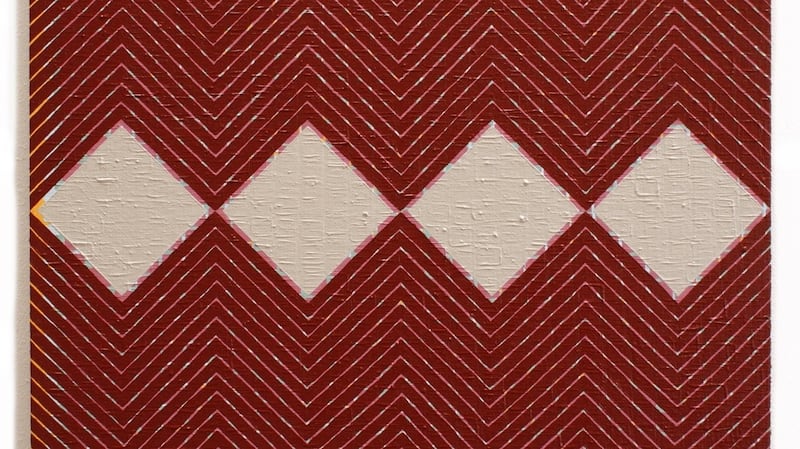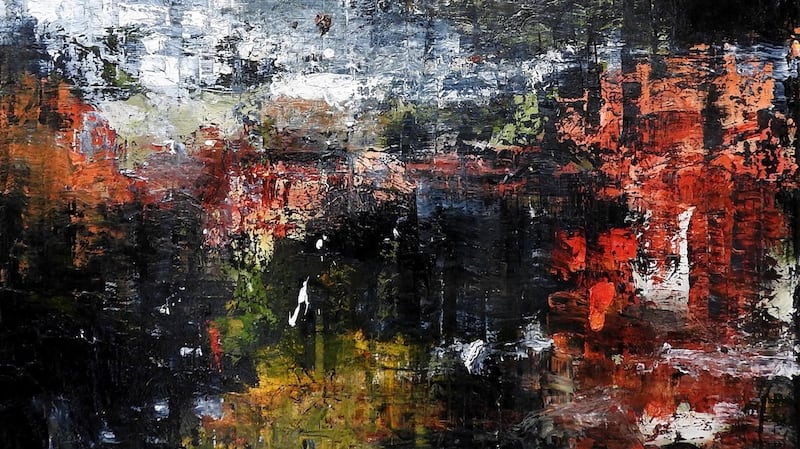Aspasia – An Influential Immigrant: Margaret Corcoran
Kevin Kavanagh Gallery, Dublin
****


What's love got to do with it? When Margaret Corcoran was mulling over making a painting about love, she came across an old book in an Oxfam shop featuring an encyclopaedic range of images capturing love through ages and cultures. These black-and-white illustrations became the basis for her show Aspasia – An Influential Immigrant. As it happens, immigration became a significant secondary theme. Born around 470BC, Aspasia made her way from her Ionian hometown, Miletus, to Athens and, against the odds, established herself in society there, being beautiful, intelligent and quick-witted. She became the lover of statesman Pericles who, following his divorce, lived with her. They had a son.
Corcoran works from photographs of a sculpture of Aspasia reclining. Other images of love – and some migration – include a Sudanese couple who seem almost to be wrestling but are in fact making a symbolic, mutually supportive arch of their bodies in a ceremony of ritual courtship. A lavish royal wedding in Bhutan also features. So do Eileen Gray, who like Aspasia established herself as a major figure in another milieu, and the writer DH Lawrence.
Exultation
A technically accomplished painter, Corcoran is here prepared to opt for a fast, provisional, sketchy approach. When she uses oil paint it is thinned and drips in rivulets down the surface. It is as though she works around the images rather than investing them with body. Starting with black-and-white images, she devised her own colour schemes, sometimes lavish. In the larger version of The Courtship, the myriad lines and drips of multicoloured pigment resemble an elaborate tapestry that is unravelling, with threads trailing all over the place. Rather than seeming chaotic or unfinished there is an exultation to this, a kind of joyousness that holds for the show overall.
Until April 22nd, kevinkavanagh.ie
Recent works: Helen Blake
Molesworth Gallery,
Dublin
****
Helen Blake’s dense, braided abstract compositions consist of rhythmic bands, lines and spots of coloured pigment. A painting is built up in many layers and each layer introduces a new colour. Her palette varies significantly from work to work and relatively speaking she uses a lot of colour, but always judiciously, stepping back from garish tones, developing harmonies that are sometimes obvious, often complex. While her basic language is that of geometric abstraction, she mostly departs from straightforward symmetries, letting each painting follow its own path. The layered, textured surfaces tell a tale of incremental coats of paint, varying amounts of each layer showing through until an end-point is reached.
Each layer can also establish a new regime of pattern, so that selective preservation of underlying layers can leave us with arrangements of distinctive emergent constructions. The process is meticulous, repetitive and entirely manual – no masking tape or other aids – so that patterns can drift away from strict geometries, and there is never that machined look to the edges. It's also intuitive at every turn. Art historically, Agnes Martin is an obvious point of reference, but so too is the Swedish mystic and artist Hilma af Klint (who features in As Above, So Below, Imma's forthcoming show on spirituality in visual art).
Modest scale
Blake's paintings suggest connections with weaving, knitting and tapestry. In their modest scale, they seem to shy away from the assertive masculinity of much abstract painting. Which isn't to say that she is trying to make any point here: presumably she works on a scale that is comfortable to her. Her working method generates surprising formal juxtapositions, with differing schemes of order overlapping and intersecting, sometimes to great effect, as in A prowler through the dark. On occasion, unpredictability is a tiny nuance: a single touch of colour in a corner, say, all that survives of an underlying layer. These small notes have a disproportionately strong optical effect.
Her titles, incidentally, are added after the fact. The paintings are in no sense illustrative of the titles. What we see emerges from the lengthy process of making. To describe the work as idiosyncratic may sound slightly patronising, but idiosyncrasy is integral to the process, and Blake has learned how to harness it to great effect.
Until April 11th, molesworthgallery.com
Remnants: Stephen Lawlor
Oliver Sears Gallery
, Dublin
****
Copying from the old master was, for hundreds of years, and still is for many people, part of a painter's apprenticeship. In Remnants, Stephen Lawlor takes on that idea with a twist. He looks to works by three great Venetian painters of the 16th century, Titian, Veronese and Tintoretto, and makes not direct copies but re-workings or variations on sections of, or complete, compositions. It's something he has done before, though in a more conscious, conceptualised way, trying out various approaches to dealing with a pre-existing, underlying image. With this new body of work, he is much more relaxed about the process and perhaps less bothered with the symbolism.
He is a restless, exploratory artist. He came to painting by way of printmaking and has, through several bodies of work, shown a willingness to present himself with new challenges, stretching and developing his use of the medium. Along the way, he has discovered that he loves paint, especially oil paint, and is enraptured by its potential. That, at any rate, is what comes across in the work.
Pictorial drama
In Remnants, while the paintings are non-representational, they pursue a lively dialogue with their sources in terms of composition and chiaroscuro. The latter enhances the prevalent mood of pictorial drama. Is there a subtext here about the risk of losing touch with a wealth of cultural heritage? Looking at two ambitious works, Canopy and Orpheus & Eurydice, certainly, there could be, particularly given our current age of anxiety. That notwithstanding, the overall implication is one of renewal and regeneration: there are always new things to see in great paintings, and more to learn from them.
Until May 4th, oliversearsgallery.com










